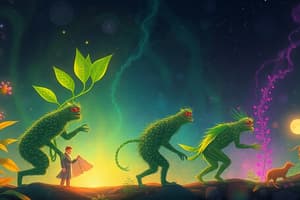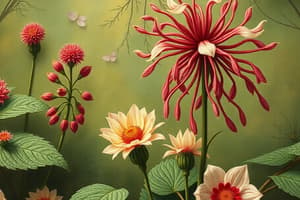Podcast
Questions and Answers
What characteristic differentiates seedless vascular plants from nonvascular plants?
What characteristic differentiates seedless vascular plants from nonvascular plants?
- Nonvascular plants can grow tall.
- Nonvascular plants live only in dry areas.
- Seedless vascular plants have vascular tissue. (correct)
- Seedless vascular plants reproduce using seeds.
Which advantage does vascular tissue provide to land plants?
Which advantage does vascular tissue provide to land plants?
- It allows plants to photosynthesize.
- It increases the rigidity of the cell wall.
- It stores energy as starch.
- It transports water and nutrients. (correct)
What is a key feature of fungi that distinguishes them from plants?
What is a key feature of fungi that distinguishes them from plants?
- They have a cellulose cell wall.
- They store energy as starch.
- They are autotrophic.
- They reproduce through spore dispersal. (correct)
What role does fruit play in the reproduction of seed plants?
What role does fruit play in the reproduction of seed plants?
Which of the following accurately describes a disadvantage of plants adapting to a terrestrial environment?
Which of the following accurately describes a disadvantage of plants adapting to a terrestrial environment?
Flashcards
Cellulose cell wall
Cellulose cell wall
Plant cells have a rigid outer layer made of cellulose, which provides structural support and helps maintain cell shape.
Vascular tissue
Vascular tissue
Plants use specialized tubes called vascular tissue to transport water and nutrients throughout their bodies. This allows them to grow tall and reach sunlight.
Seed
Seed
Seeds offer protection for the developing plant embryo, enabling plants to survive harsh conditions and spread to new locations.
Fungi as decomposers
Fungi as decomposers
Signup and view all the flashcards
Fungi are closer to animals than plants
Fungi are closer to animals than plants
Signup and view all the flashcards
Study Notes
Plant Characteristics
- Plants have cellulose cell walls, store sugar as starch, and have specialized tissues (roots, leaves, stems).
- They photosynthesize using a green pigment.
Plant Evolution and Adaptation
- Plants adapted to land by developing vascular tissues, seeds, flowers, and fruit.
- Early land plants lived near water.
- Vascular tissue allows plants to grow tall and transport water and nutrients.
- Benefits of moving to land: more sunlight, CO2.
- Disadvantages: less water/support, harder reproduction (spore dispersal).
Plant Groups
- Nonvascular plants: lack vascular tissue, seeds, and flowers/fruit; reproduction difficult due to lack of seeds—often live in moist environments.
- Seedless vascular plants: possess vascular tissue (allowing tall growth), but lack seeds, flowers, and fruit; typically located in or near water, e.g., ferns.
- Seed plants: have both vascular tissue and seeds; can thrive in dry environments.
Plant Structures and Functions
- Vascular tissue: tubes transporting water and nutrients throughout the plant (xylem transports water, phloem transports sugars & other nutrients). This allows for tall growth.
- Seeds: protect the developing plant embryo and allow for long-term survival. Seeds are easily dispersed (moved from parent plant).
- Flowers: involved in plant reproduction.
- Fruit: develops from the ovary of a flower. Fruit attracts animals, and the animals disperse the seeds.
Fungi Characteristics
- Fungi are heterotrophic (obtain nutrients by consuming other organisms).
- Fungi are more closely related to animals than plants.
- They reproduce via spore dispersal.
- Fungi have chitin cell walls.
Fungi Environmental Impact
- Fungi are decomposers, breaking down dead plants and animals, and contributing to maintaining the environment.
Studying That Suits You
Use AI to generate personalized quizzes and flashcards to suit your learning preferences.




